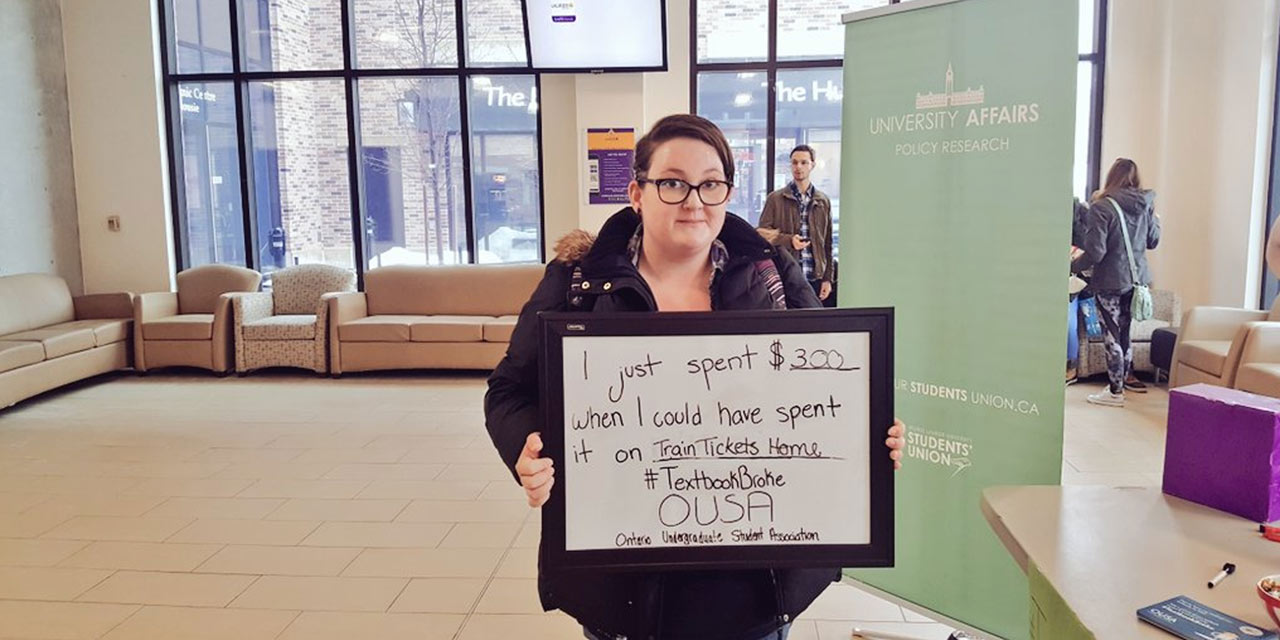A student social media campaign is shedding light on the high cost of university textbooks, and the digital solutions that could save students thousands of dollars.
The Ontario Undergraduate Student Association’s #TextbookBroke campaign is asking students to share their receipts from recently purchased textbooks, along with where they’d rather see that money go, in order to increase awareness of the real costs of education.
Fawziyah would have rather spent her $79 on Freshii, what would you spend that on? Rent, phone bill? The use of #OERs would give you that freedom. Talk to your profs about #TextbookBroke ! pic.twitter.com/xViv4dNLOV
— MSU Advocacy (@MSU_Advocacy) September 13, 2018
According to the Canadian Federation of Students, today’s classes are the most indebted in Canada’s history, with an average debt of $28,000 at graduation—an issue exacerbated by the rising cost of tuition and learning materials. In the United States, 65 percent of students reported not buying a required textbook because they couldn’t afford it.
https://www.instagram.com/p/BeoVyyUHOfa/
https://twitter.com/19M4Y97/status/951296815499960320
Josh spent $300 on textbooks when he would have rather spent that money on food! @OUSA #textbookbroke #foodovertextbooks pic.twitter.com/dLmZ9OZEIB
— MSU Advocacy (@MSU_Advocacy) January 12, 2018
Landon Tulk, the vice-president of Western’s University Students’ Council, told CBC Radio: “So many students are coming back this semester and many of us are asking, ‘Is this required textbook really worth $200, $300, $400 even?’ When that could pay for my rent for the next month, my groceries for the next four to six weeks.”
“There are so many challenges students are facing at the moment and the #TextbookBroke campaign is starting to highlight what those challenges really are.”
#TextbookBroke
Would love to be able to spend some money on groceries. It would also be helpful to have some money to get me though the semester. I appreciate what you are doing OUSA. pic.twitter.com/r3IZvE64vt— Monica Raudales (@MonMon_Awesome) January 12, 2018
https://www.instagram.com/p/BdidVC_HtS9/
In addition to raising awareness of the problem, the campaign is also aiming to put the focus on a solution: textbooks that are open educational resources, or OER. Tulk says this solution would be a fraction of the price.
“Let’s say you’ve been assigned a 200-page textbook at a cost of about $150, the alternative would be an open textbook that is licensed so that you can access it, download it… So now you’re looking at $10 or $12 or $15 compared to that $150 you would have spent for that exact same material.”
Instructors should also consider their use in class because the quality is often the same as the higher-priced textbooks, said OUSA’s VP of Finance, Shannon Kelly.
Waking up to being in @AcademicaTopTen is a pretty awesome feeling especially when it's on an issue you really care about! #TextbookBroke 📚💻 pic.twitter.com/c01McziDfo
— Shannon Kelly (@shannonekelly9) September 17, 2018
#TextbookBroke is also spreading in the US, with one student lamenting the fact that lack of access to physical textbooks is hurting their learning:
Crazy that we're 3 weeks into classes and people still don't have their books. if we switched over to #OER, Huskies wouldn't be in this situation. #TextbookBrokehttps://t.co/c3ED5DS6Jy
— UConn Praxis (@uconnpraxis) September 12, 2018
A recent study in the International Journal of Teaching and Learning in Higher Education found that when OER was introduced in US universities, it improved end-of-course grades and decreased DFW rates for all students. The effect was greater for part-time students, and populations historically underserved by higher education.
https://www.instagram.com/p/Bd52Od_hjlL/
If you’re in Ontario, here’s how you can help the campaign:
- Share your thoughts on the campaign on Twitter using #TextbookBroke
- Visit ecampusontario.ca to explore potential alternatives for textbooks on your curriculum. Plus, Top Hat Textbook delivers free or low-cost textbooks to your students’ devices—select them in the Top Hat Catalog.
- Start a dialogue: Talk to students in class about their textbook outgoings—you may be surprised
Related story
Should I rent or buy college textbooks?

Free Tool
Find out how much money your students could save if you ditch print textbooks.
Try our Textbook Affordability Calculator.


